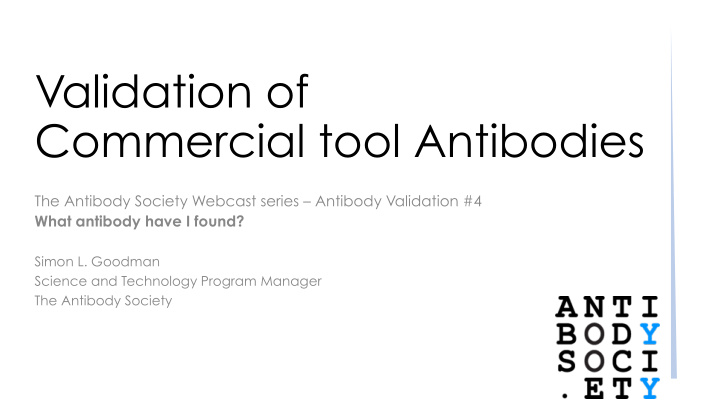



Validation of Commercial tool Antibodies The Antibody Society Webcast series – Antibody Validation #4 What antibody have I found? Simon L. Goodman Science and Technology Program Manager The Antibody Society
Antibody Validation: a 9-part series The different antibody formats Andreas Pluckthun : 1. : Antibodies and the reproducibility crisis in biological science 2. Glenn Begley : The Erß story – is your antibody like this? Cecilia Williams : Beware the supplier OEM 3. Jan Voskuil Finding antibodies in the Antibody Databases Andy Chalmers : Which antibody are you looking for? The RRID Anita Bardowski : 4. Points to note on the supplier datasheets Jan Voskuil : Correct positive and negative controls in validation 5. Giovanna Roncador: : : Standard technology: “even” Western blots are non-trivial 6. Aldrin Gomes : IHC issues in brain sciences Jim Trimmer : Cell KO technology Travis Hardcastle 7. : Validating Antibodies with KO technology Alejandra Solache Validating antibodies using array technologies 8. Mike Taussig : Mass spectroscopy for mass validation Fridjhof Lund-Johansen : Why publish sequences? Andrew Bradbury : 9. Andreas Pluckthun : What are the coming alternatives ?
What antibody have I found? The Antibody Society Webcast series – Antibody Validation #4 Anita Bardowski UCSD; SciCrunch Jan Voskuil Aeonian Biotech
What antibody have I found? The Antibody Society Webcast series – Antibody Validation #4 Anita Bardowski UCSD; SciCrunch Jan Voskuil Aeonian Biotech
RRIDs are essential for rigor and transparency The Antibody Society Webcast series – Antibody Validation #4 Anita Bandrowski, PhD Dept. Neurosci. UCSD SciCrunch Inc. August 2019
Rigor and Transparency in Research *2016- Grant Review Criteria* • Scientific premise • Scientific rigor • Consideration of relevant biological variables, such as sex • Authentication of key biological and/or chemical resources
What about resources? Key resources vary from lab-to-lab and application-to- application, and are the source of variability in many experiments. “…all grants must include a 1 page attachment informing reviewers how grantees plan to authenticate key biological and chemical research resources”, including: • Cell Lines • Antibodies • Transgenic organisms • Specialty chemicals
Why does the NIH talk about reagents? Papers are currently poor at identifying the simplest part of the paper, the materials used Vasilevsky 2013
Authors do not put enough information into papers to find antibodies 1 clone name: 7 products hi. I hope this gray-out is what you had in mind? Nat Immunol. Author manuscript; available in PMC 2019 Aug 18.
How can this problem be solved?
RRID Syntax to save the day! DSHB Cat# GAD-6, Lot #12, RRID:AB_528264 Global Unique Version or Company or Local Persistent Provider Identifier Lot used Identifier
Authors added 100K RRIDs to their papers since 2014 I fitted to ppt 16:9 format
How do publishers know what to do with RRIDs?
Reminders during the publishing process do work!
RRIDs = Better papers Bandrowski et al, 2015
Are there benefits to using RRIDs over just adding the catalog and lot number?
Vendor names changing, reselling, ..oh my! • Antibodies validated for an application, how do authors know? • Vendor may pull products • Vendor names may change • Notes on independent validation: • ENCODE • RRID publications • Originating manufacturers One 3 companies RRID
RRIDs are reported in many databases and catalogs
To register your antibodies! To put RRIDs into your next paper! To review papers for methods! Comments / Thoughts: anita@scicrunch.com
Recommend
More recommend